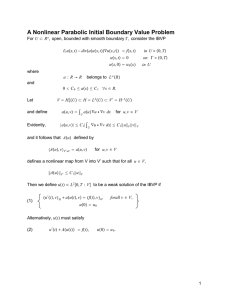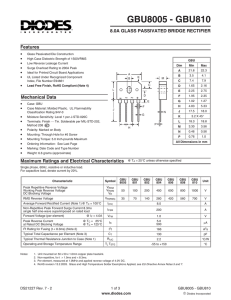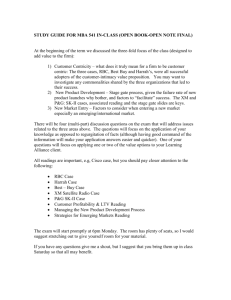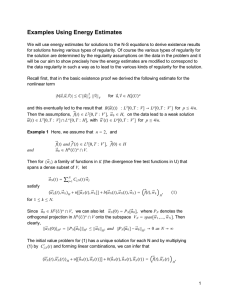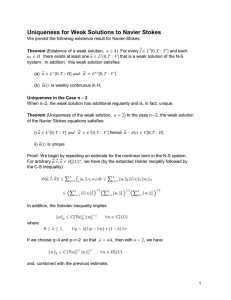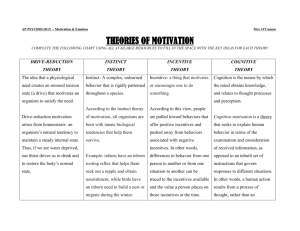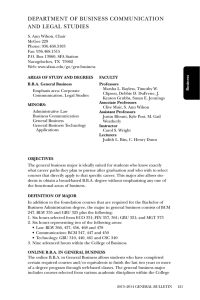Class Notes 6 - Faculty Server Contact
advertisement
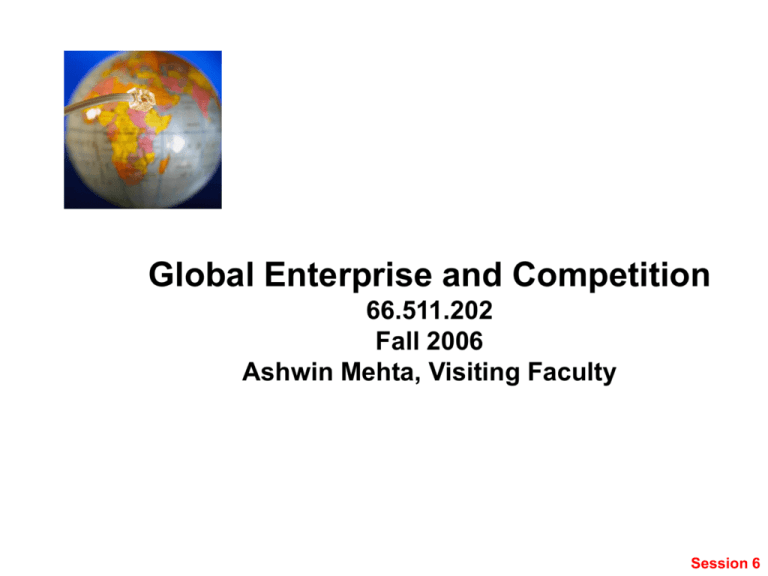
Global Enterprise and Competition 66.511.202 Fall 2006 Ashwin Mehta, Visiting Faculty Session 6 Global Enterprise Management Culture Strategy Standards Coordination Global/Regional (standardization) Local sales Production Logistics Marketing Frontline cust support Procurement R&D Call Centers Backend customer svc Session 6 IMPORTANCE OF INTEGRATING CORPORATE, BUSINESS & INTERNATIONAL STRATEGIES Consistency requirements - purposes/goals Resource Allocation Internal Financing Portfolio Balance Growth & Profit Guide Business Strategy Formulation Set Business Performance Objectives Develop Business Performance Criteria Potential Issues Communication between Corporate & Businesses Role of Business in Corporate Portfolio Clarity of Business Strategies Performance Metrics and Incentives Structures Session 6 Global Leader* Question Our businesses are aligned around a common corporate culture Performance management is adequately focused on enterprisewide objectives We are effective in integrating operations globally to exploit economies of scale Our businesses have a centralized compensation structure Our company makes frequent use of expatriate assignments We are effective at sharing local innovations around the world Our managers are willing to sacrifice local priorities to benefit the global enterprise We do a good job developing new approaches centrally and diffusing them worldwide Global Leaders 90% Peer Group 87% 63% 85% 68% 83% 79% 69% 68% 55% 51% 55% 51% 64% 53% 71% Global Leaders=Top 3 companies in the industry on effectiveness in conducting business globally *: Fortune Feb 2006 Session 6 Global Enterprise Strategy Implementation 1. Organization Structures 2. Coordination and Information sharing 3. Human Resource Management 4. Incentives 5. Communication across cultures Session 6 Multinational Firms Organizations International Division Underneath geographical structures Most common and is simple greater reliance/dependency on domestic operations – more overhead Functional division International functions reporting into domestic functions R&D functions reporting to domestic R&D, etc. Low overhead, works well with limited product offers coordination among functions could be a challenge Product division good for companies with many different offers (like consumer goods companies) Redundancies Geographical division More popular with companies having large International presence Matrix division Better coordination/communication and information sharing Complex Potential for a politicized Session 6 Groupe Bull (France) Product Line Mgmt (PLM) Strategy Staff Bull HN (US) R&D Mfg Mktg Admin Geographic UK Italy International Canada Pacific Global Corporate/Business Strategy PLM mainly R&D focused Products global Mission assignment by product US-Mainframe and Mini France-Mid range, UNIX Italy-Small end etc. Implementation poor Local mgmt with power Lacked central leadership Cultural differences Bull (France) R&D Mfg Mktg Admin Sales France Germany etc. Session 6 Geographic Area Structure for a Multinational Corporation Board of Directors President Corporate Staff R&D Operating Companies U.S. Product Group A Operating Companies Europe* Product Group B Operating Companies Latin America Product Group C Operating Companies Africa Operating Companies Asia* Product Group B *Note: Because of space limitations, product groups for only Europe and Asia are shown here. Product Group D Session 6 Global/MNE’s Before – established companies adapted to new global environment incremental markets view Now --- new companies and industries are “born” global primarily from developing countries (e.g. India) home markets too small and moving to go global Primary markets view Accessing scarce resources (specially human) Session 6 Global/Multinationals Challenges Country Managers CEO SBU head Business managers Functional managers Session 6 “Up the (E) Organization! A Seven-Dimensional Model for the Centerless Enterprise”, Neilson, et al, Strategy+Bsiness, 2000 Session 6 Measuring impact of structures Cost/Benefit Analysis and Measurements Organization as a System: Input, Throughput and Output Process Specialization --- Throughputs based (functional Org’n) Purpose Specialization --- Output based (Divisional, Product, Geographic, Customer) Session 6 Measuring impact of structures Functional Benefits Costs Divisional Expertise, critical mass Economy of scale and scope Efficiency Avoid duplication of resources Career benefits Focus Effectiveness Fewer coordination issues Quick response to changes Coordination costs Functional myopia Loss of “big” picture Bureaucracy Duplication of scarce resource Potential loss of economics and efficiency Session 6 Measuring impact of structures Efficiency Effectiveness • Cost per • Economics of scale • Duplication of resources • Coordination costs • Market share • Customer satisfaction • Revenue Growth • Time to market • Product introduction Functional Structure “ Doing Things Right” Divisional Structures “ Doing Right Things” Session 6 Centralization Vs Decentralization There are 2 basic forms of organization structures: Centralize or Decentralize --“If one does not work, try the other!” Typically companies use both types of organizations Right mix Sequential Decision Process Efficiency and Effectiveness requirements Centralization/Decentralization mix Tall Vs Flat Organizations Inertia Expertise issue Responsibility Lateral Communication The Corporate Center Primarily includes efficiency (HR, Legal, Purchasing, IT, etc.) Expanded Center: Strategic Management function; Executive Ed function; and “Centers of Excellence” Session 6 Relationship between Strategy and Structure Demands of Strategy Low cost Focus Differentiation Mix Global Strategic Drivers of Structure Choice Type of Strategy Need for Efficiency/Effectiveness Market and Technology Relatedness Size/Growth Session 6 Effective Coordination and Information Sharing Integration/Coordination required between organizations to completely execute strategy Structures give static view Integration makes structures work Dell Focused Systems of Activities to Reduce costs Improve Delivery Improve customer service Create a competitive advantage Activity Systems Session 6 Effective Coordination and Information Sharing Information/Knowledge Sharing GE Work Out Challenge and Stretch Learning Culture Structure and Process of Work Out An example of Reciprocal Interdependence Session 6 Effective Coordination and Information Sharing Issues with Information/knowledge Sharing Formal Vs Informal Open Vs Guarded Power and Influence Filtered Session 6 Effective Coordination and Information Sharing Responsibility and Accountability Type of structure and interdependence will either add clarity or make it complex Centralized/Pooled Clearer responsibility & Accountability Matrix/Reciprocal Highly unclear Responsibility Matrix Session 6 Human Resource --- Management and Staffing Challenges When do you use Expats When do you use Locals How to create new class of employees Glopats Scarcity of management talents Ten Steps To A Global Human Resources Strategy, John A. Quelch, Helen Bloom Strategy+Business, 1999 Session 6 Use of Expats Pros - Product/culture knowledge - Easy & Efficient corporate relationships -Technical/business skills not locally available -Transferable skills -Protects/promotes company interests in JV’s, M&A -Less chance of competition -Career Path Cons -Hi Costs -Black outs and Brown outs -Long start-ups and wind down time -Short sighted focus -Out of sight, out of mind concern -Re-entry issues -Lack of available management Session 6 Use of Locals Pros -Cheaper -Language/culture of the country -Local market/custom knowledge -Skills in managing local staff -Project local company image -Educated Cons -Demand>Supply -Takes time to bring to speed -Lack corporate contacts -Protection of IP’s -Control of JV’s (loyalty concern) Session 6 Session 6 Incentives Incentives Good objectives --- measurable Incentives tied to objectives Motivating objectives and incentives Objectives should not be “all or nothing” Reward the right things Session 6 Incentives Evaluation Controls Strategy and Objectives Actual performance Significant deviation? Cause-effect analysis/learning Continue Rewards/corrections Actions/change Session 6 Culture Affects Performance Culture Behavior Performance Corporate culture clashes - a leading cause of merger failures Organization Performance Affects Culture Culture Behavior Performance Feedback and Change (new behavior) Session 6 Culture Company/Corporate Culture Sub-cultures and Managing Differences National/Regional Culture Work Vs Customer Implications Session 6 Global Enterprise and Culture Most critical factor in doing business Globally, and least-understood Culture is a set of norms that are generally accepted within a society Culture has levels: national; regional; and, organizational Understanding these cultures in a country/region is important in conduct of a business Business blunders if market cultures not fully understood Key question: how does culture affect workplace values? Customer behaviors Management of operation Managers must study and understand cultures before launching a Global business Session 6 Culture’s Importance in Strategy Implementation -Dell launched a new web site in Japan with black borders Black is considered negative in Japan; Consumers did want to do anything with Dell Localization did not just mean language translation -When Gerber first started selling baby food in Africa, they used the same packaging as in the USA - the cute baby on the label. Later, when investigating lower than expected sales figures, they found out that it is common practice in Africa to put pictures of the contents on food package labels. -Workers Participation in work planning may not work everywhere -Going Global and Acting Local Session 6 Customer Country and Competitor Country Features P&G JAPAN SKII © Professor Daniel F. Spulber Session 6 P&G Internationalization Evolution 1930 – 1970’s Strategy: International Market Expansion Country level focus -Tailor to meet needs -Common structures, Policies, practices Issues: Cost Global introduction 1980’s Cost Innovation Coordinating Regional org’ns -overlapping structures To minimize differences 1990’s New untapped markets Global management -strategy -technical programs -marketing O2005 Innovation - GBU taking over profit Country level -profit Session 6 How did international business considerations affect the P&G strategy and organization? P&G Reorganization: CEO Durk I. Jager reorganized from four geographical business groups to: • Seven global business units (GBUs) based on product lines (baby care, beauty care, fabric & home care, feminine protection, food & beverage, health care, tissue & towel) • Decentralization: R&D, product supply, marketing, information technology, finance, human resources • Market Development Organizations (MDOs) at both the regional and country levels, feed consumer and market knowledge into GBUs • Global Business Services: accounting, payroll, order mgmt • Corporate Functions staff will move directly into the GBUs • Mirrored global retailer expansions (Wal-Mart, Carrefour) Session 6 Organization 2005: Objective: transform Global planning and management system into a more innovative and quicker system Old structure: countries Global area design, organizing around country or O2005: organize around products or product groups convert 4 geographically based business units to 7 global BU’s around products create 8 market development org’ns to adapt global programs to local markets Global business services (accounting, HR, IT, etc.) Redefine corporate staff roles; move to other departments Success: Swiffer – test phase to global product in 18 months multi-department effort Session 6 Global business unit (GBU) Extends strategic business unit (SBU) organization to international business Headquarters Division managers create and implement strategies on a global basis GBU 1 GBU 2 GBU 3 Division managers responsible for products, pricing, marketing, sales, R&D, financing, procurement on a global basis Session 6 What made SKII a success in Japan? • Product developed in Japan • P&G adjusted the product features, marketing and sales to the local market • Substantial consumer interest in beauty products • Emphasis on customer service • High willingness to pay • Multiple-step treatment favored by consumers Session 6 The Legend For almost a generation, Japanese women have known a secret. This secret was discovered by a Japanese monk who visited a sake brewery in Kobe. He was surprised to discover that the brewery workers had extraordinary soft and youthful hands. Even an elderly man with pronounced wrinkles on his face possessed the silky smooth hands of a young boy. This observation encouraged the monk to conduct a series of experiments. He eventually discovered a clear, nutrient-rich liquid that could be extracted during the yeast fermentation process. He shared his findings with a group of skincare scientists, who became equally excited by the potential of his discovery. http://sk2us.com/index.htm For the following five and a half years, intensive research was undertaken to understand more about this magical seemingly 'age-defying' liquid. Session 6 The Discovery The team of scientists were able to pinpoint the exact fermentation process required for this liquid to achieve its maximum potency and harness its magical youth-giving powers. They named the liquid 'Pitera'. Pitera, which contains a collection of vitamins, minerals, amino acids and organic acids, became known amongst researching scientists as 'the secret key' to beautiful skin. Many things can upset the delicate balance of your skin, from stress to hormonal fluctuations. Pitera helps restore the skin's natural rhythm by stimulating its renewal process. The result is skin that is clearer, smoother and wonderfully radiant. Through nature's miracle, Pitera, women have discovered a totally new skin experience - the joy of reborn skin. Session 6 The Ritual Visualize Empty your mind and visualize your skin now and in the future. Purify Apply a small amount of cleanser with your fingertips, using slow circular motions, until your skin feels clean, awakened and refreshed. Renew To experience the Pitera magic, sprinkle about a teaspoon of Facial Treatment Essence into the cupped palm of your hand. Rub hands together and press gently and evenly onto face and neck, stimulating the renewal of the skin’s outer layer. Enhance Complete the Ritual with any of the following treatment options based on your specific needs: Anti-Aging, Illuminating, Refining, Nourishing and/or Boosting. Session 6 Issues in the SK-II Global Strategy • • • • • • • Not invented here Vertical organization issues: Getting management to buy in Would a Japanese product sell elsewhere? Too many new products in pipeline Budget pressures in Beauty Care business Not a mass market product Requires change of company strategy in sales effort and choice of distribution outlets • Conflict with heads of GBU Session 6 Making the case for SK–II • • • • • • Incremental revenues Addresses prestige market segment Diversifies P&G’s cosmetics product lines Investment in sales and marketing will yield positive returns Innovation should originate throughout the GBU Coordination of national and regional strategies is the task of the GBU Session 6 Customer countries and Competitor countries Evaluate the strategy for making SK-II a global brand • Development of initial market in Japan provides test market Will the company be able to extend the brand effectively: • Hong Kong and Taiwan? • Singapore, Malaysia, South Korea? • China? • Europe? • United States? Session 6 P&G O2005 issues/problems Changes applied too quickly responsibility issues/concerns BU’s competing with each other Resistance by employees morale, defection Status 2004: Jager was forced out, replaced by Lafley Stopped the changes Adopted “global matrix” organization – blend of geographical and product BU’s Session 6 SK-II is brought to the US and sold at Saks Fifth Avenue stores Store display for SK-II Session 6 Discuss Danone Case “Danone: Organizing for Global Competition” Session 6
